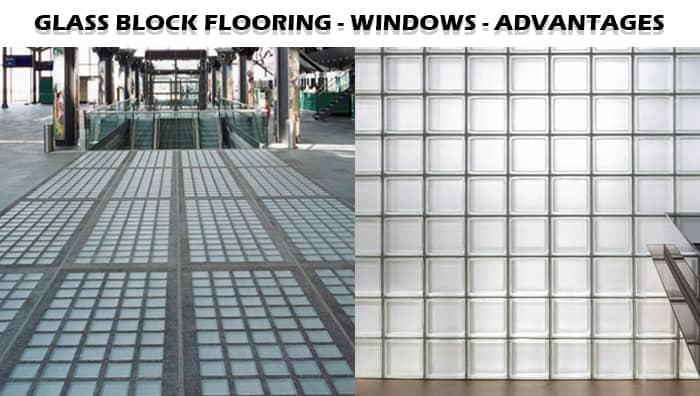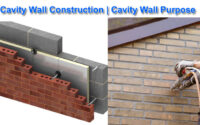What is Glass Block Flooring | Glass Block Types | Uses, Advantages, and Disadvantages
Glass block flooring can be found on balconies, hallways, public areas, mezzanine floors, bridge walkways, and other places. They are most typically used as pavement lights, which involve putting glass lenses into precast concrete as part of pavement construction in order to enable natural light into the area below.
They were created in the 1880s as cast iron frames with cut-glass glazing to provide natural lighting for cellars and basements under the pavement. These were eventually replaced by reinforced concrete panels with plain glass fenestration, but these were later replaced by prism lenses made of pressed glass, which were intended to transmit the most amount of light possible.
Although they can be built on-site, they are typically precast in factories under controlled conditions in the UK, according to the requirements of each project.
Pavement lights and other precast concrete panels with glass blocks or paver inserts are not currently covered by any British or European regulations. Manufacturers are required to test their pavement light products for compliance with any local authority or building rules, loading, thermal, acoustic, and fire performance.

Uses of glass block:
- They are utilized in both residential and commercial building interior decoration.
- Bathrooms that accept the light and beauty of the bathroom can also utilize glass block wall panels.
- These blocks can be utilized for wall cladding projects that improve the aesthetic appeal of commercial structures.
- In a walk-in shower, these blocks can be used to create the illusion of space and add light.
- Glass blocks make excellent windows because they let light in.
Types of glass block:
1. Wavy Glass Block Windows:
- Basement home windows are frequently made of the most widely utilized type of window.
- The wavy pattern maintains seclusion while allowing light to pass through.
2. Clarity Glass Blocks Window:
- Such glass blocks home windows and is frequently used for kitchen windows, although it does not provide privacy.
- Typically, windows are built using traditional materials, which prevent light from entering the structure when the windows are closed.
- The particular material that is frequently utilized to allow sunlight into the room is glass block windows.
- Glass block windows contribute to the building’s enhanced architectural appeal. The most common form of windows used for basement windows are glass block windows.
- In-home design, glass block windows are frequently used, particularly in the restrooms.
- The best thermal insulation is provided by glass block windows, which are equivalent to double-pane windows.
- Consequently, give as much light as possible.
3. Ice Glass Blocks Window:
- These are frequently utilized as bathroom windows.
- This is apparent because of the frosted design, which takes into account gentleness but ignores visibility.
4. Diamond Glass BlockS Windows:
- Diamond glass blocks are clean for contact, in contrast to wavy and ice blocks, because the design is inside the blocks.
Advantages of glass block:
- Glass blocks allow soft natural light to pass through the window.
- It offers privacy.
- They are available in a variety of styles.
- Provides safety.
- It offers tolerance.
- It offers good thermal and acoustic insulation.
- They are exceedingly tough.
Disadvantages of glass block:
- Due to the high temperatures needed to melt raw materials, making glass requires a lot of energy.
- Alkali solution causes corrosion to occur.
- They are brittle.
- Unsafe for regions subject to earthquakes.
FAQ
1. What Is Glass Block Floor?
Balconies, corridors, public thoroughfares, mezzanine floors, bridge walkways and other locations all make use of glass block flooring. In order to provide natural light into the space below, they are most frequently employed as pavement lights, glass lenses embedded into precast concrete as part of pavement construction.
2. What is Hollow Glass Block?
In order to create hollow glass wall blocks, two distinct halves of the glass are first made. The two halves are then pushed together and annealed while the glass is still molten. The resulting glass blocks will have a hollow center that is partially vacuumed. Based on the framing that they are installed in, glass block walls are restricted.
3. Uses of Glass Blocks
Early in the 20th century, the glass block was created to let natural light into factories. why glass bricks are used Glass block is a flexible building material that can be used for paving, interior and external walls, windows, stairwells, shower screens, and much more.
4. Disadvantages of Glass Blocks
However, there are some drawbacks to using glass blocks. Glass block windows are not the greatest choice for places that tend to accumulate humidity since the material condenses moisture from the air. It can roll down and gather on the window frame when moisture condenses in the glass block.
5. Advantages of Glass Blocks
The benefits of energy efficiency that glass block windows provide are comparable to those of thermal pane windows. There is no chance of air leaks because they are typically sealed with mortar in the wall. This improves heat control while reducing noise and dust ingress, which can help you save a lot of money on your utility bills.





